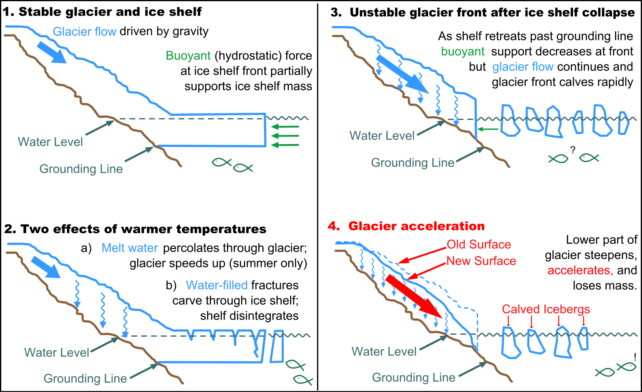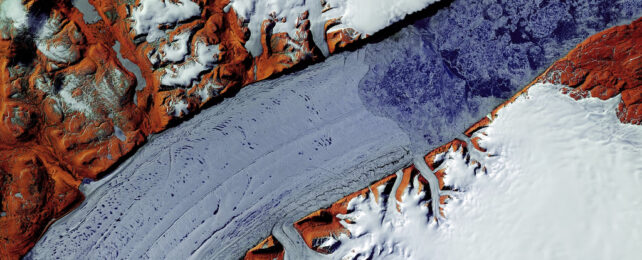A closer look at the junction where a Greenland glacier crunches into the ocean floor, known as its grounding line, has revealed less stability amid the shifting of tides – and therefore a greater rate of melting – than previously estimated thanks to global warming.
The finding explains why rates of glacier melts are well surpassing previous forecasts.
"These dynamics are not included in models, and if we were to include them, it would increase projections of sea level rise by up to 200 percent – not just for Petermann but for all glaciers ending in the ocean, which is most of northern Greenland and all of Antarctica," says Eric Rignot, an Earth systems scientist from the University of California, Irvine (UCI).
Unlike the edge of ice shelves that extend above the ocean which naturally fluctuate to some extent between seasons, traditionally the grounding line wasn't thought to migrate during tidal cycles. But satellite records reveal how warmer waters have altered this dynamic.

UCI glaciologist Enrico Ciracì and colleagues analyzed the satellite data for Petermann Glacier's grounding zone in Northwest Greenland. This glacier has enough above-sea-level-ice to create a 38 centimeter (15 inch) global sea rise, should it completely melt into the ocean.
Together with two of its neighbors, the Petermann Glacier forms the largest threat for rapid sea level rise from Greenland. Because they're grounded below sea level, most of their meltwater drains directly out into the ocean.
High-resolution satellite observations reveal tidal ice migrations that cover a number of kilometers.
"Petermann's grounding line could be more accurately described as a grounding zone, because it migrates between 2 and 6 kilometers as tides come in and out," explains Ciraci.
"This is an order of magnitude larger than expected for grounding lines on a rigid bed."
All this movement has also carved out a 204-meter (670-foot) tall cave at the base of the glacier that allows warm water to eat further away at the ice.
"The grounding line migrates over considerable distances in response to tidal forcing, which brings a large amount of ocean heat, at high speed, beneath grounded ice," the team writes in their paper.
Since around 2016 Petermann's own grounding line has been retreating a rapid 1 kilometer per year. Overall, the glacier's grounding line retreated just under 4 kilometers, or 2.5 miles, between 2016 and 2022.
What's more, the most rapid melt rate the team recorded was within the grounding zones – up to 80 meters per year at peak melt.
However, University of Delaware glaciologist Andreas Muenchow, who was not involved in the study, cautions that these findings still require further investigation.
"[T]he very high melt rates are real, but they are estimated over very small areas," Muenchow told The Washington Post.
"My main takeaway is that models need to be improved," he adds. "The study provides a sharper focus for what processes we need to study near floating glaciers in Greenland or Antarctica, if we want to project rising sea levels into the future using models."
The Greenland ice sheet has already increased sea levels by 14 millimeters since 1972 by contributing billions of tons of water that was previously locked up in land ice to the oceans. This is due to surface melt from warmer air temperatures, and now we know warming water is also contributing more to the melt than previously realized.
"These ice-ocean interactions make the glaciers more sensitive to ocean warming," says Rignot.
Given hundreds of millions of people live on small isles or low-lying coastal areas, losing these massive stores of water at both of Earth's poles will put 1 in 10 people at direct risk from rising sea levels. What's more, the water stores' disappearance will trigger massive changes in ocean currents that will have a ripple effect across the world, further altering our climate systems.
So every increment of warming we can avoid, by working together to hold those most responsible accountable, and helping each other make better collective choices matters.
This research was published in PNAS.
